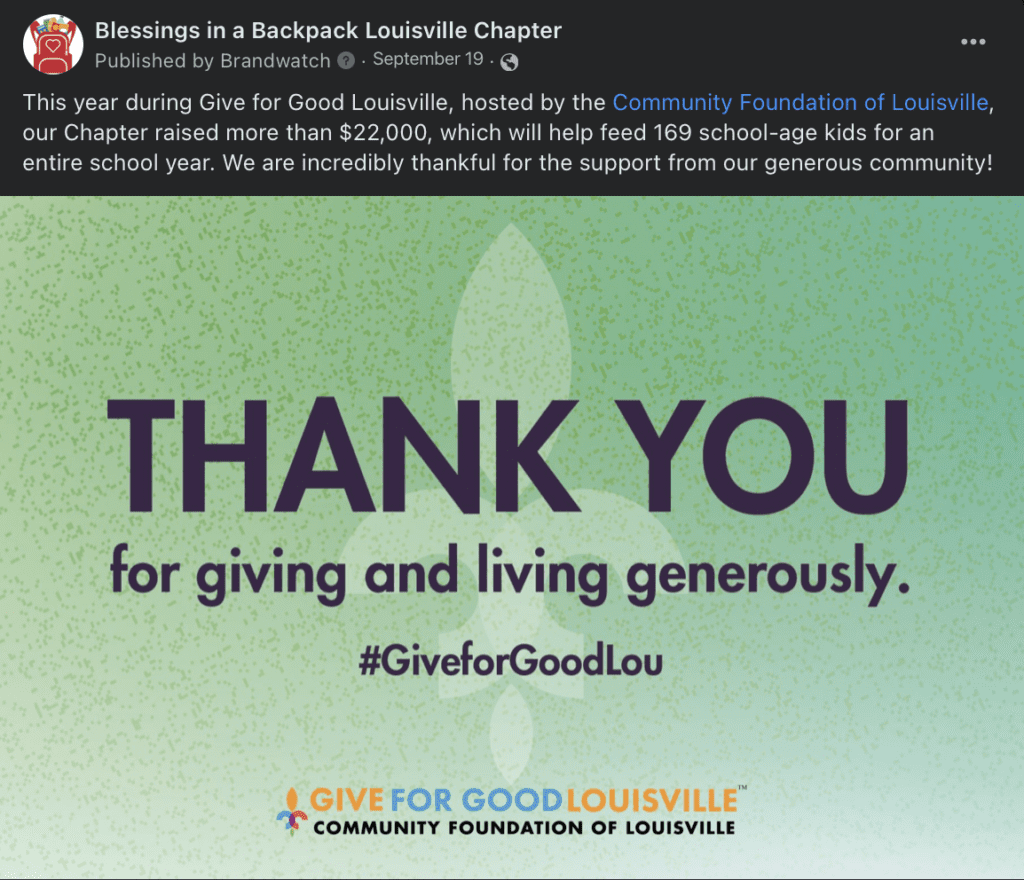
8 Nonprofit Social Media Tips To Make Yours Stand Out
Whether helping homeless individuals, providing a safe place for stray animals, or feeding the hungry (the list goes on and on), nonprofits do great work for our communities in countless ways. While they may have different missions, many nonprofits fall short in the same area: their presence on social media.
There are many reasons nonprofit organizations aren’t consistently active on social media, including short-staffing, fear of over-asking and annoying their followers, or not knowing what to post—to name a few.
As someone who works with nonprofits daily to help spread awareness of their missions and dedication to bettering the community, I’ve seen firsthand how impactful a social media presence can be.
In this edition of Plain Talk, we’ll discuss eight nonprofit social media tactics you can use to increase your online presence and help further the awareness of your mission to make a change.
- 1. Make a Content Plan
- 2. Share Success Stories of Recipients
- 3. Utilize Volunteer Testimonials
- 4. Share Your Mission Frequently (But Not Repetitively)
- 5. Show the Measurable Impact You’re Making
- 6. Share How the Community Can Get Involved
- 7. Interact With Your Audience
- 8. Consider Creating a Boosting Budget
- Get Expert Help With Nonprofit Social Media Strategy
What can you do to build your nonprofit’s brand awareness on social media?
1. Make a Content Plan
Start by identifying your content pillars
What do you really want to get across to followers? What are the main pillars that are important to your company to show online? Selecting these themes will help keep your content consistent, effective and relevant to your followers. For instance, are donations crucial for your organization? Consider focusing one of your content pillars on “Donating” posts. Are there impactful success stories showing how your organization is helping in the community? A “Testimonial” pillar may need to be one of your main pillars. Determine your overarching pillars, guiding you in creating content that will resonate with your followers.
Use current trends
According to Marketing Elect, participating in relevant viral trends helps to portray your organization as “modern, relevant, and entertaining,” which leads to positive brand awareness and increased engagement and followers.
If a meme or soundbite is already spreading like wildfire, take advantage of the formula provided for you by tailoring the content to fit your organization and mission. For example, a trend that took off earlier in the year was the “Little Miss” meme because the simple format was easy to duplicate and hyper-personalize.
This trend was utilized by nonprofits, for-profit businesses and social media users alike. It lasted several weeks, which is a lifetime when compared to other viral trends, garnering more than 375,000 posts on Instagram, according to Parade. Participating in easily shareable trends, such as “Little Miss,” is a great way to gain impressions and engagements; but, make sure the trend is relatable to your organization. You don’t want to force a post just because the joke is going viral.
2. Share Success Stories of Recipients
This is your way to show how your organization is truly making a difference in people’s lives and the community. Sharing success stories is also a way to show followers just how critical your nonprofit is to the community, encouraging them to reach out or donate to support your mission.
In addition, success stories are a great way to weave in user-generated content (UGC). Using photos from those impacted by your organization—your clients—is another way to bring a personal aspect and authenticity to a post. Using UGC helps to create trust between an organization and a follower. MediaToolkit reports that consumers are 2.4 times more likely to say UGC is more authentic than the brand’s content.
3. Utilize Volunteer Testimonials
Volunteers are a crucial element of a nonprofit organization. Sharing their stories on why they are passionate about your organization and mission and why they love to support you is a great way to recruit more volunteers. Use direct quotes from volunteers to help create a sense of credibility with followers. Using a video testimonial directly from a volunteer would be the most impactful so they can share their complete story. As a bonus, a video like this would also be UGC and thus could help increase trust between your followers and your organization.
4. Share Your Mission Frequently (But Not Repetitively)
Every nonprofit’s mission is its core, and spreading awareness is always the goal. However, using multiple ways to voice that mission is critical to avoid content fatigue. Content fatigue occurs when social media users become numb to specific visuals and phrases.

By creating different ways to phrase your mission and your organization’s purpose, you can avoid followers aimlessly scrolling past your posts, thinking they have already seen or read them. This is the same when it comes time to select images and graphics to use with your copy. Choosing different highly visual photos for each post is essential to grab followers’ attention as they scroll through their feeds. When an image is used multiple times, you run the risk of the user passing by without a second glance.
5. Show the Measurable Impact You’re Making
Using statistics can help establish your organization’s impact within the community and the need for your services. Many people might not be aware of the segment of the society you’re serving, and sharing the hard facts can shed light on why your mission is crucial.
For example, most community members are aware that there is a large population of homeless individuals in Louisville. But do they also know that since 2018, there has been a 41% increase in the number of people experiencing homelessness? Or are they aware that one in six children in Kentucky faces hunger? Sharing data like this will tug on the community’s heartstrings, spark engagement and solidify why your nonprofit is needed to help make a difference.

6. Share How the Community Can Get Involved
Support from the community is another essential factor in a nonprofit’s success. When planning your social media calendar, include posts announcing opportunities for community members to attend fun or impactful events, volunteer their time or donate directly to your organization.
Ensure that what you’re asking for is straightforward by using a direct call-to-action, such as “Follow this link to register as an event volunteer” or “Click here to donate today!” Not everyone has the time or money to donate every time, so you can also ask people to simply share your posts to spread awareness. This provides a way for followers to support your organization for free. By sharing a post, they could direct a new user to your page who can get involved immediately or have a lasting impact on your nonprofit.
7. Interact With Your Audience
It may seem simple, and might be information you’ve heard before, but we can’t stress enough how important community management is to all brands and organizations. Interacting with your audience is key to keeping followers coming back and engaging with your content and will help create a positive image of your organization.
Liking and responding to a comment from a follower in a timely manner shows that you see and appreciate them interacting with a post. If someone asks a question, answer it quickly and to the best of your ability to ensure the person is obtaining the information they may need to begin benefitting from your organization or volunteering with your organization.
When a community member or company tags your organization in a post, like and comment thanking them for their support, and share their post to your own page or Instagram story to show your gratitude. Sharing posts from other organizations is free and a great and simple way to get more relevant content on your page. As a nonprofit, it’s important to take advantage of free opportunities like this when they arise.
Responding to negative comments
Another crucial time to engage with your audience is when a negative comment is posted. You don’t want a negative comment to sit on your page without action. Start by replying to the statement and asking this person to direct message you on your page or provide an email where they can send you their feedback – offline. It’s best to take a negative conversation away from the public view and into a private space where you can thoroughly discuss the issue. Ignoring or deleting a negative comment can lead to the person continuing to post negative messages on your page, which could also turn away other followers.
Responding to a negative comment is especially crucial if someone calls into question your services, funding or overall organization and those it helps. Your goal as a nonprofit is to better the life of a community member, and that starts with hearing their honest feedback. Truly take into consideration what someone has to say, which might help you to create a better experience for others in the future. At the same time, we all know social media trolls exist. If your situation involves a troll or bot that is harassing or vulgar, make sure you have a plan in place on how to address these types of remarks as well, which may include hiding comments or banning users in this situation.
8. Consider Creating a Boosting Budget
When social media was first created, the best part of the platforms was that everything was free. Free to sign up, engage with followers and promote your organization. While it’s true that it’s still free to create an account and engage with followers, organic reach has plummeted over the years. Social Pilot reports that the average organic reach for a Facebook post is only 6.4% of the page’s total likes. Facebook creators have admitted to changing the algorithms to prioritize posts from friends and family, but a decline in organic reach has only encouraged organizations to boost posts and buy ads. It has called into question whether this was an intentional move from Facebook to get more organizations to spend money on paid content overall.
Nonprofits typically have limited budgets, and when it comes to spending additional funds on social media, it can be a hard pill to swallow. However, it’s slowly becoming essential to create a boosting budget so that your content is even seen as you are competing with endless numbers of organizations on social media sites.
How to boost an event or opportunity
Consider setting aside a chunk of money, even if it’s only $100 a month, to specifically use for boosting events or volunteer opportunities to a targeted audience. Facebook allows companies to create a detailed targeted audience. Utilize the information you already know about your current supporters and donors to start selecting the demographic categories for your targeted audience. This can be anything from age range and gender to education level. You can also target your ad to a specific location, which is helpful for locally-based nonprofits.
Another significant category for targeting is the “interests” section. Choosing an audience interested in nonprofits and community support is a start, but you can get specific to the type of event you’re hosting. For example, for a post about an annual golf scramble, consider adding a “golf” or “sports” interest to your audience selections. This will help reach a larger group of potential new followers and users interested in attending your event.
Get Expert Help With Your Nonprofit Social Media Strategy
Overall, social media is an excellent tool for nonprofits to share their mission and events with new and existing followers. However, balancing day-to-day work with the ever-changing social media platforms and algorithms can be tricky. If your nonprofit is seeking assistance with social media, send us a message or give us a call at 502.499.4209. We are ready to help!
Our Articles Delivered
Signup to receive our latest articles right in your inbox.


